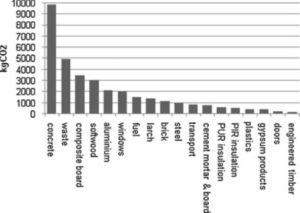
Of the UK’s total energy consumption 24% is attributable to the domestic sector [1] and of this embodied carbon could account for 6-10%. Despite this embodied carbon is not, in general practice, a consideration when a building is designed, specified and constructed.
An interesting assessment by Monahan & Powell (2011) considers the carbon emissions of a building’s lifecycle and examines the difference between the embodied carbon of a MMC home and a traditional masonry home [2]. This paper identifies three common stages of a buildings lifecycle: construction, occupation and end of life destruction. Understandably there have been considerable efforts to reduce carbon emissions produced during the ‘occupation’ stage as this accounts for the majority of the building’s lifetime carbon footprint as well as the drive to Net Zero encouraging this effort.
As energy consumption requirements reduce during the ‘occupation’ stage the embodied carbon from the ‘construction’ is likely to contribute to a greater proportion of overall lifecycle carbon emissions (ranging from 9-46%) than it would for a traditional house (ranging from 2-36%). Despite this, policy is currently lacking to reduce embodied carbon from the initial construction of the building.
Monahan & Powell’s (2011) study suggested that for the ‘construction’ stage of a low energy, affordable house in 2008 (MMC timber frame larch cladding house) with a total footprint area of 45.3m2, the total embodied carbon was 34.6tCO2. Whereas a traditional masonry home of this size the embodied carbon was 52tCO2, concluding a MMC home has a lower embodied carbon when compared to a traditional home.
Figure 1 shows 82% of embodied carbon is based within materials of the building (exclusive of waste). Examples of materials the MMC house required are 56,651kg of concrete with an embodied carbon of 9863kgCO2, 1,315kg of larch producing an embodied carbon of 1,421kgCO2 and 260kg of aluminium with an embodied carbon of 2140kgCO2. This highlights the importance of measuring and accounting for the embodied carbon of materials during construction of a building.

Figure 1: Summarised inventory results showing embodied carbon in construction of a 45.3m2 MMC house (Monahan & Powell, 2011)
A further concern with regards to embodied carbon is associated with waste, on site construction often involves error related over ordering resulting in 10-15% of materials imported to a construction site being exported as waste (5350kg of waste is equivalent to 4.934kgCO2 of embodied carbon). This suggests waste accounts for a significant proportion of a buildings embodied carbon and therefore should be measured and managed accordingly.
From 2022 the UK aims to deliver 300,000 new homes per year [3] which will have significant implications for the UK’s carbon budget. The ‘Future Homes and Buildings Standard’ also expects new homes built from 2025 to produce 75-80% less operational carbon emissions compared to current regulations [4], indicating embodied carbon will likely account for a greater proportion of overall lifecycle carbon emissions. The magnitude of which this will impact on the carbon budget will depend on how these homes are constructed and if embodied carbon is considered.
If you would like to know about the embodied carbon of your organisation, please get in touch.
[1] Energy Envoys: What’s energy used for?
[3] House of Commons Library: Tackling the under-supply of housing in England
[4] Gov.uk: Rigorous new targets for green building revolution
Photo by Polina Chistyakova from Pexels: https://www.pexels.com/photo/white-building-exterior-surrounded-trees-and-gardens-2815150/
